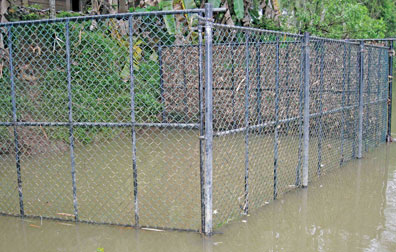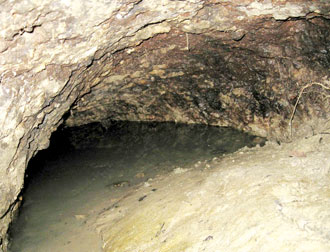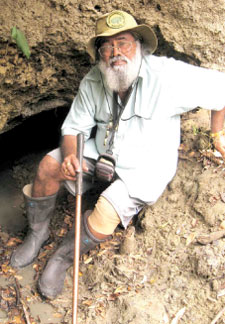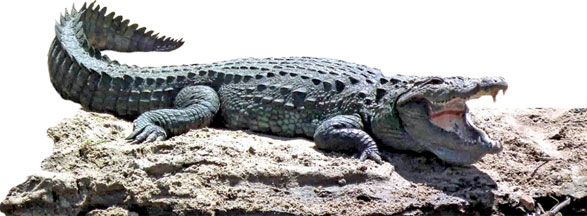Human crocodile conflict
Need for a Conservation Action Plan:
By Dhaneshi YATAWARA
According to legend the yearling of the female crocodile which lived
in the Matara river (Matara Kimbuli) was not a man eater. Yet
interpreting this peculiar female crocodile character is still debatable
among the literate. There are numerous explanations for this 'Matara
kimbulige petiya'. This story is not a literature survey on the poem.
This is an expedition on the current situation the crocodiles of Matara
are facing.
The commonest crocodile in the country is the mugger crocodile known
as 'hela kimbula' in Sinhala. According to Sri Lankan herpetologists the
mugger it has only a few favoured natural habitats left where most of
these habitats are cleared, altered and under pressure by human
activities. The salt water crocodile or the saltie is a common sight
along the Nilwala river in Matara. Today these salties struggle for
their survival giving rise to human - crocodile conflict. The IUCN 2007
Red list recorded the salt water crocodile under the 'nearly threatened'
category.
 |
| A modern crocodile
exclusion enclosure in the Nilwala river |
 |
|
Mugger burrows - some are about 20m deep |
 |
|
Anslem de Silva |
Human-crocodile conflict mitigation involves both awareness and the
building of some expertise in controlling 'nuisance' crocodiles as well
as strategy for translocation when found necessary," said Vice Chairman
Crocodile Specialist Group of the IUCN/Species Survival Commission for
South Asia and Iran Anslem de Silva. "However, we should be extremely
careful of such translocation as the 'homing' instinct of this species
is now well established," de Silva explained based on his research in
the Nilwala river carried out to investigate the reasons for
Human/Crocodile conflicts. The three day research funded by the Mohamed
Binzyed Conservation Fund, basically focused on proposing methods on how
to minimise this conflict among the vulnerable communities inhabiting
the Nilwala river from Modara (the Lands-End) up to Paraduwa in Matara
district.
On their three day mission the researchers collected data on eight
human deaths due to crocodile attacks and ten cases of attacks resulting
in minor injuries. "However, it is felt that most of these accidents
might have been prevented if the victims knew some of the basic safety
measures," Anslem explained.
Highly threatened
The alarming revelation in the survey was that 95% of respondents
considered that crocodiles were not useful or rather did know the
ecological roles played by the crocodiles.
Many have said crocodile flesh has curative properties for asthma and
improves eyesight.
Although the crocodile is a protected animal, under the Flora and
Fauna Act it is illegally hunted mainly for its flesh. Destruction of
crocodile eggs and clearing its natural habitats still continue. In
addition, occasionally a man-eater gets killed. "Shooting or capturing
any specific man-eater is still questionable as an Australian study in
2005 (Caldidicott et al.) indicated that there is no guarantee that the
crocodile responsible for the attack could be captured," Anslem de Silva
further explained.
Killing of yearlings and sub-adults which get trapped in fishing nets
is another threat crocodiles face in Matara. Some drown in the fishing
nets and die. "In fact, one fisherman informed me that he killed five
young crocodiles that had got trapped in his fishing nets in the past,"
de Silva said. Occasional attacks on humans give crocodiles a bad
reputation. Just a single confirmed man-eater inevitably leads to many
of the crocodiles in the vicinity being killed.
Forty-seven percent of the people interviewed have said that they
have heard that when a crocodile holds on to its victim, the stomach or
the belly of the crocodile should be stroked or tickled, then it will
release its bite, whilst 53% did not know any methods to escape from a
crocodile's grip. "when I was a young boy my family was living in the
ancestral house in Fort, Matara near the Nilwala River during the
1950's. Those days I kept a yearling saltwater crocodile for about four
years which I collected from Nilwala River. During this period, in order
to verify this popular belief, I use to stroke the belly of the captive
crocodile, which responded immediately by becoming passive and did not
struggle.
When repeated it produced the same results," de Silva said. Using
another yearling crocodile during the present study, de Silva
experimented the same method and the animal has shown the same
behaviour.
Dumping garbage on the river bank attracts crocodiles as well as its
predators like the water monitor. It was observed that large water
monitors ('Varanus salvator') swallowing crocodile yearlings as well as
large crocodiles swallowing adult water monitors.
"During the survey, we found out that several slaughterhouses and
fish stalls discard their refuse into the river, and in two such places
crocodiles are attracted when fish and beef by-products are thrown into
the river," de Silva said.
The water monitor attacks and feeds on large number of animals,
including other reptiles, such as venomous and non-venomous snakes and
crocodile yearlings and crocodile eggs. In addition, eagles, hawks and
mongoose have all been observed to prey on yearlings.
Human errors
"Regarding the human-crocodile conflict and attacks, investigations
revealed that in almost all the case studies the fault was on the part
of human beings.
Many use insecure crocodile pens for bathing and washing," de Silva
added.
Regarding the approximate length of the crocodiles seen by the
interviewed families, 76% stated that they have seen crocodiles possibly
measuring over 3 meters in length. Nearly 46 % of respondents have
observed crocodiles between 10a.m. to 1 p.m.
An intensive awareness program coupled with protective measures like
installing crocodile-pens, crocodile-fences and installing warning sign
boards in risk areas should be carried out, he suggests.
As far as crocodile attacks on pet and farm animals is concerned,
most of these attacks have taken place in the river-land interface,
pointing to the negligence of the respective owners of these animals.
"During our survey of residents living near the river we observed
that some tie their dogs in the backyard of their homes adjoining the
river, which prompts the dog to bark at the slightest disturbance which
unfortunately attract crocodiles to attack these pets," he explained.
Most of the riverine mangroves have been depleted mainly due to human
activities.
As de Silva further explained the people living along the river
should be informed of the legal aspects of the river reservation area,
such as the 20 metre river bank reservation that belongs to the
government, thus any destruction of the mangroves may be liable for
legal action.
Install proper crocodile pens in places where it is need by the
community. Installing a crocodile fence where crocodiles frequent into
compounds during the night.
Crocodile fences
To enhance aesthetic and traditional beauty I recommend building a
durable pen using Kitul planks on 3 sides which will create a 10 x 5
metres square, de Silva explained.
 |
|
Mugger crocodile (hela
kimbula) in Yala |
But it should be strongly secured from the front with strong wire
mesh with a door.
The kitul planks should be around 15 centimetres wide and when
installed in water they should be approximately 1.5 metres above the
river water level during high tide. The space between two planks should
be 10 centimetres. There should be a rough concrete platform and steps
leading up to the water.
Considering the fences it should be erected on a secure foundation
and should be constructed so that half the land area is for the
occupants and the other half for the river or rather for the crocodiles
to prowl at night.
"Thus, we create land area for the crocodile, as well as protect the
people and their pet animals. This technique has never been attempted
anywhere in the world.
In addition, a door should be fixed to this fence so that people
could use both land spaces during the day," de Silva explained.
Crocodiles are a keystone species that maintain ecosystem structure
and function through selective predation on fish species, recycling of
nutrients and maintenance of wetlands in drought. Thus, it is important
that we conserve these reptiles and their natural habitats.It is felt
that a Conservation Action Plan should be initiated in the country which
addresses the specific issues of the country, according to de Silva.
Fortunately, major natural habitats of the mugger are in some of the
wildlife reserves, such as Yala and Wilpattu National Parks.
|

